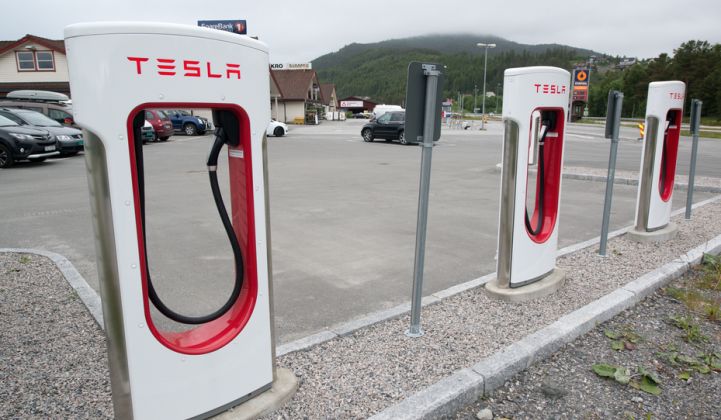This month, Norway inaugurated the world’s largest electric-vehicle charging station -- part of a plan to build stations every 50 kilometers on the country's main roads by 2017.
The record-beating station in Nebbenes, near Oslo, features 20 Tesla Superchargers, four 50-kilowatt fast chargers and four medium-fast charging points. It is part of a "charge and drive" network being built by the Finnish utility Fortum in partnership with Tesla.
Fortum is said to have installed 160 new fast-charging points in Norway so far this year and is ramping up rollout plans to meet the one-charger-per-50-kilometer target for next year.
The project is being managed by Enova SF, a Norwegian government body under the Ministry of Petroleum and Energy. Enova started issuing public tenders for a national fast-charging network last year.
Norway’s other major charging infrastructure provider, Grønn Kontakt, this month announced the construction of 14 new fast-charging stations awarded through an Enova tender.
When complete by the end of next year, the rollout should see at least 150 double multi-standard fast-charging stations installed across the 7,500 kilometers (4,660 miles) of main road in the country.
Norway currently has 7,065 charging points, including around 400 fast- and semi-fast charge stations. The number reflects a long history of support for electric vehicles in Norway. In 1990 Norway introduced a temporary exemption of purchase tax for electric vehicles.
The exemption for electric vehicles was made permanent in 1996, when the government also scrapped road taxes for EV owners. In 1997, it exempted them from charges on toll roads, and in 1999 it gave them free municipal parking.
Electric-vehicle owners have continued to enjoy greater financial benefits in recent years, with a 25 percent sales tax exemption in 2001, access to bus lanes granted in 2005, and no charges imposed on road ferries in 2009.
Faced with this increasingly wide range of benefits, car owners in Norway have opted to go electric in growing numbers. This year, the country passed the 100,000 mark for battery and plug-in hybrid electric vehicles on the road.
The share of battery electric vehicles in the market, meanwhile, has increased from 1.4 percent in 2011 to 16.9 percent today, according to the Norwegian EV Association.
That level of penetration puts Norway “five to 10 years ahead” of any other country on the planet in terms of electric-vehicle adoption, said Christina Bu, the association’s secretary general.
But while vehicle ownership has risen significantly in the last five years, investment in charging infrastructure has lagged.
Despite Norway being far ahead of any other country in terms of charging points per capita, with roughly one station per 730 people (compared to one per 2,640 in the U.S.), there is still concern among car owners over the availability of stations.
In fact, studies of EV owners have revealed that the big challenge for electric-vehicle adoption is not range anxiety per se, but rather "charger anxiety" -- the fear that once you reach a charging station there may be massive queues or the plugs might not work.
The Enova tender process aims to end such fears through a major government funding package. So far the government agency has spent almost NOK50.6 million ($6.1 million) on three funding rounds for a total of 230 fast-charging stations.
Another funding round, with an undisclosed sum, was announced this month. Sites are awarded to developers promising to build the stations at the lowest cost.
Helping in the development of the national fast-charger network is a growing awareness of the business model for EV charging. Most of the time, electric-vehicle owners charge their cars at home or at work, said Bu. But charging stations are growing in popularity as people drive farther afield, and have emerged as valued stopping-off points where travelers can rest and grab a snack or a drink while waiting for their vehicle batteries to charge.
This has led to partnerships between the charging-station network firms and roadside retail chains. Grønn Kontakt, for example, is placing charging stations at Circle K outlets, while Fortum is working alongside Shell.
“Service providers like petrol stations now really want fast chargers because they understand this means more money, an increase in income,” said Bu.



